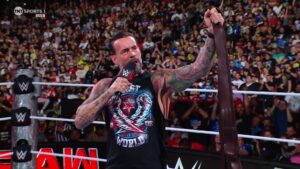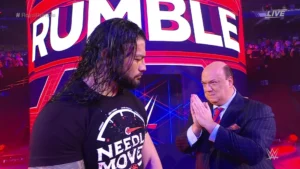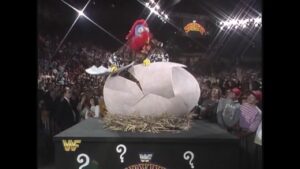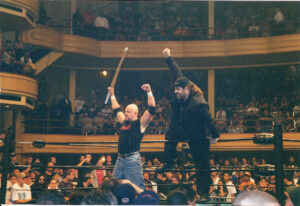The news that former CMLL Women’s World Champion, World Tag Team Champion and NJPW Strong Women’s Champion, Stephanie Vaquer has signed with WWE has proven yet again the benefits of a competitive wrestling market.
Only a short while ago at Forbidden Door were a wider range of fans exposed to the tremendous skill and star power of Vaquer. Although the 31-year-old has been wrestling since she was 16 and competed across the world, it’s only recently that she appeared on many fans’ radar. To learn more about “Primera,” check out this article.
WWE and AEW fans were desperate for their side to claim Vaquer. This is despite at the time being CMLL’s top female wrestler. Historically, it was not that long ago when wrestlers did not have the power to bargain. Nor the luxury of choice.
This is one of the many benefits of competition between two strong, financially backed promotions. Others I’ve discussed in AEW and how in five years it’s changed wrestling. The Forbidden Door/Prohibited Portal has and will continue to benefit fans and wrestlers alike.
We are living the reality that was once a fantasy booking. The wrestling industry from the top down has changed.
— Stephanie Vaquer (@Steph_Vaquer) July 10, 2024
Spotlighting
Those promotions allied with WWE and AEW are also benefitting from this ‘Cold War’ in various ways.
The working relationship between AEW, NJPW, CMLL and STARDOM has already resulted in a phenomenal amount of dream matches. It’s exposed many Western fans to brilliant and talented wrestlers from across the world.
For me, as someone on the level below a casual NJPW fan, seeing Minoru Suzuki or Tomohiro Ishii compete made me seek out more of their matches. Both Hechicero and Mina Shirakawa are mine (and others) 2024 “discoveries”.
Seeing Suzuki or Ishii on an AEW Dynamite or Hiromu Tanahashi on AEW Collision is still a treat. Even if it’s just the new normal, the fact Bryan Danielson can wrestle Blue Panther and it’s no big deal shows how much we “sickos are spoiled.
In terms of talent trading, Jack Perry’s stint with The House of Torture resulted in the ‘Scapegoat’s’ second chance. It turned the former Jungle Boy’s weakness into a strength upon his return. If expanded, other AEW wrestlers could benefit from an excursion (which I’ve discussed here).
For TNA Wrestling, their return to relevance has been bolstered by their partnership with WWE NXT. It’s hard to argue the WWE spotlight has helped make two of TNA’s stars feel like superstars.
Jordynne Grace and Joe Hendry were already achieving some level of engagement and exposure before their NXT appearance. Grace had appeared in the Royal Rumble. Hendry stormed the charts with his song “I Believe In Joe Hendry” and went viral.
Stars Are Born (and Reborn)
WWE’s creative and commercial Renaissance has made many new signings must-watch wrestlers. For many of these wrestlers, the hype is well deserved. The spotlight gives many of these veterans a chance to show what many already knew.
The hype around the ‘Samoan Werewolf’ Jacob Fatu has existed since the early 2020s. Fans of MLW like me have been shouting Fatu’s praises for years. If you’re looking for recommendations for his early work, check out this article.
Former STARDOM headliner Giulia was trending on X before even sitting ringside at an NXT event. WWE’s spotlight is long-established. It’s bright. It can make new stars quickly when properly utilized.
When Jade Cargill jumped to WWE, for some fans she instantly became legitimate and credible. As the oldest and most successful promotion in the game, and running hot, talent trades feel like the ‘Monday Night Wars.’
Some will demean or undermine AEW’s star-making potential. Yet the similarities in presentation of wrestlers like Cody Rhodes and Jade Cargill down to Ethan Page and Shawn Spears in AEW and WWE are minimal. Likewise, AEW’s allowed others to progress or re-invent themselves.
Will Ospreay and Kazuchika Okada might have headlined in the Tokyo Dome for NJPW but became a weekly TV character on Dynamite. Christian Cage has become a patriarch who some fans would disown their fathers for. “Timeless” Toni Storm has become one of the strongest characters in wrestling (her development I’ve analysed here).
Swerve Strickland and others have shown what WWE missed out on.
Some tribalistic detractors might call them rejects. Target AEW’s issues. Bluntly, some of these “rejects” are making more money, enjoying creative satisfaction and enjoyment than their detractors.
Competition Means More Money
I’ve written before about the misunderstood fan perception that AEW overpays and that WWE underpays its wrestlers. I pointed out that AEW paying wrestlers more is a good thing. Fans who begrudge wrestlers who want to work for the promotion that offers them the most money need to ask themselves is that how they approach their employment.
Unlike other sports, wrestlers in WWE only make 10% of the company’s profits. For most other American sports franchises, it’s 50%. The myth of “poaching” during the Monday Night Wars ignores more than WWE’s poaching behaviour with the territories. The water coolers were removed from Titan Towers during the financial downturn of The New Generation Era.
However, those office workers were not physically putting themselves at risk of injury through taking bumps each evening without medical insurance. Like many of the wrestlers who at times lost money travelling to shows.
As profits and new revenue streams open, wrestlers being able to negotiate for higher salaries and additional rights is a good thing. More places to work means opportunities for more money.
For wrestlers such as Vaquer, it means after years of grind, one match, one stand-out performance everything can change. Attention means multiple doors. Even beneath the top tier, there are other wrestling promotions further down the hierarchy where wrestlers can still make a living.
At the same time, AEW offers more to many wrestlers beyond money and a bigger, more established spotlight. Less time on the road, more creative and personal freedom to pursue other aspirations (things I’ve written about here). The allure and opportunity to build the alternative despite growing pains.
The Rising Tide
The proverb a rising tide lifts all ships is a false myth. The super yachts are raised highest, and their ripples often rock the smaller vessels. Sometimes unintentionally flooding or capsizing them. WWE being hot has impacted AEW’s business and the wider wrestling landscape. This isn’t to dismiss things that are good for fans and wrestlers. Both gain the net benefits.
There is a lack of equilibrium in the wider wrestling ecosystem, even within the partnerships both companies are cultivating. This is not a criticism or to suggest either WWE or AEW is doing anything wrong from a business standpoint.
Usually in business relationships between companies of different sizes, the gains for one might outweigh the gains of the other. Morals or ethics for either company aren’t for discussion.
Ultimately, it’s the nature of capitalism. There are pull factors for why AEW and WWE are more attractive to wrestlers. Many have already been discussed. In business, competition should inspire innovation and creativity. Competitors need to adapt.
Yet it doesn’t have to be as ruthless as the motto on an old Evolution t-shirt: Adapt or perish. Promotions can be stagnant and remain static. They can regroup and rebuild, but realistically within the financial backing or platforms that AEW or WWE offer, this can take time.
Outside Interference
Some push factors are within a company’s control. In theory, for NJPW to rebound, offering more money is part of the answer to losing talent. Also, changing booking patterns to draw crowds to make more money and regain acclaim. What once drew record crowds and buzz has become uninspired and cliché. The latter requires time. Nevertheless, the former is impacted by external issues.
Covid impacted the Japanese economy. The yen’s value has weakened. The country is still recovering from a record-low GDP in 2022. If the money isn’t there, companies like NJPW will inevitably lose their top stars. In turn, potentially extended the time it will take for them to rebuild and recover.
In the states, the outside inference of the Pandemic contributed to ROH’s closure. Yet not before losing a portion of its top stars who founded AEW. MLW once looked like it could leapfrog ROH. The spiritual successor of ECW likewise created a “homegrown” roster of talent who seemed perfect for “the main roster”.
Most have since moved on in hopes of bettering their careers. Alex Hammerstone has gone to TNA. The Von Erichs have flirted with AEW/ROH. Jacob Fatu to WWE.
These factors are not the fault of WWE or AEW. It’s not the wrestlers’ fault either for wanting more. Competition will in time encourage promotions to give more to take, trickling from the top promotions down. It is the nature of work.
To work hard, get promoted, and go somewhere to earn more money. This is most people’s reality. Others want other additional things to satisfy other aspects of themselves beyond the financial. Yet the financial is the driving factor. The direction of movement desired is up.
A Change to The Ladder
For the longest time, WWE was alone at the top of the pinnacle as the place for wrestlers to earn the most money and global recognition. In the 2010s, NJPW and ROH became the promotions for the craft of wrestling. TNA offered a frenetic shape-shifting alternative that hit a ceiling. Then there were the indies underneath this.
All formed rungs on the ladder that were available to talent who could be offered the chance to climb up. Each offers some sense of compromise. Pick money or art. Pick the states or Japan. Sacrifice creative satisfaction for more financial security. Risk slipping off the ladder completely. Many wrestlers remain “what ifs” after their WWE careers from the mid-2000s to early 2010s due to a lack of options. With limited places for reinvention with enough security.
Now, the ladder seems more like scaffolding. At the top is still WWE. AEW’s position is secondary, but some prefer the view. Optimistically, they see the potential for more skyward growth. In turn, pressuring WWE as it grows to offer more.
Underneath, there is a hierarchy. Some companies that right now are fixed or risk shifting in position. But for the wrestlers, there are more ways to move. The fact some can and will cross from one side to another with the chance of gaining more is new.
Some might reach the top, and slip down, only to forge their new position where they are happy financially and creatively in a different spot. Think of Matt Cardona or The Young Bucks before him. Many won’t stay as static as they did before.
More From LWOS Pro Wrestling
Header photo – AEW – Stay tuned to the Last Word on Pro Wrestling for more on this and other stories from around the world of wrestling, as they develop. You can always count on LWOPW to be on top of the major news in the wrestling world. As well as to provide you with analysis, previews, videos, interviews, and editorials on the wrestling world. You can catch AEW Dynamite on Wednesday nights at 8 PM ET on TBS. AEW Rampage airs on TNT at 10 PM EST every Friday night. AEW Collision airs Saturday at 8pm Eastern on TNT. More AEW content available on their YouTube.






